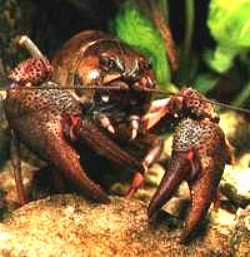Accept
Details & settings
This website uses cookies for cookie consent and statistics.
Benedikt Broich, Hendrik Nettersheim, Philipp Wegener
Sadly, domestic crayfish have disappeared from all but few waters in the Eifel.
|
The domestic species include European crayfish Astacus astacus (see figure), and stone crayfish, Austropotamobius torrentium. Orconectes limosus, Pacifastacus leniusculus, Astacus leptodactylus and Procambarus clarkii are invasive species of crayfish that have been introduced by humans and spread. With the introduction of Procambarus clarkii came the crayfish plague, which is deadly for native crayfish species and has caused them to disappear from many waters. Furthermore, about 100 years ago the native varieties of crayfish were still hunted and eaten in Germany. Hunting and the crayfish plague are responsible for the small number of crayfish that can be found in the Eifel today. |

|
We are concerned as domestic crayfish are threatened by the crayfish plague, invasive species of crayfish, chemical waste and organic waste. Due to pollution, crayfish can find or build hiding places in fewer waters. As it is hardly possible to clean natural bodies of water, we decided to investigate the ideal hiding spots, so that clean bodies of water can be modified to become more suitable as crayfish habitats. In this way we hope to help the crayfish population recover.
The project idea came up after Hendrik introduced the topic of crayfish at an open day. Therefore he learned about crayfish and we got interested as only little is known about these animals.
Therefore, we also aim to film these nocturnal animals at night in order to discover what they do. Through learning about these animals we may find other ways of helping them.
It would be great if the domestic crayfish population could recover in the Eifel and throughout Germany.